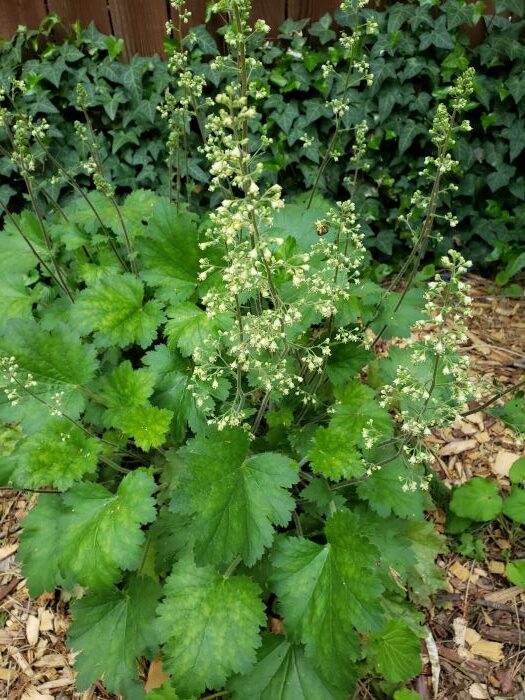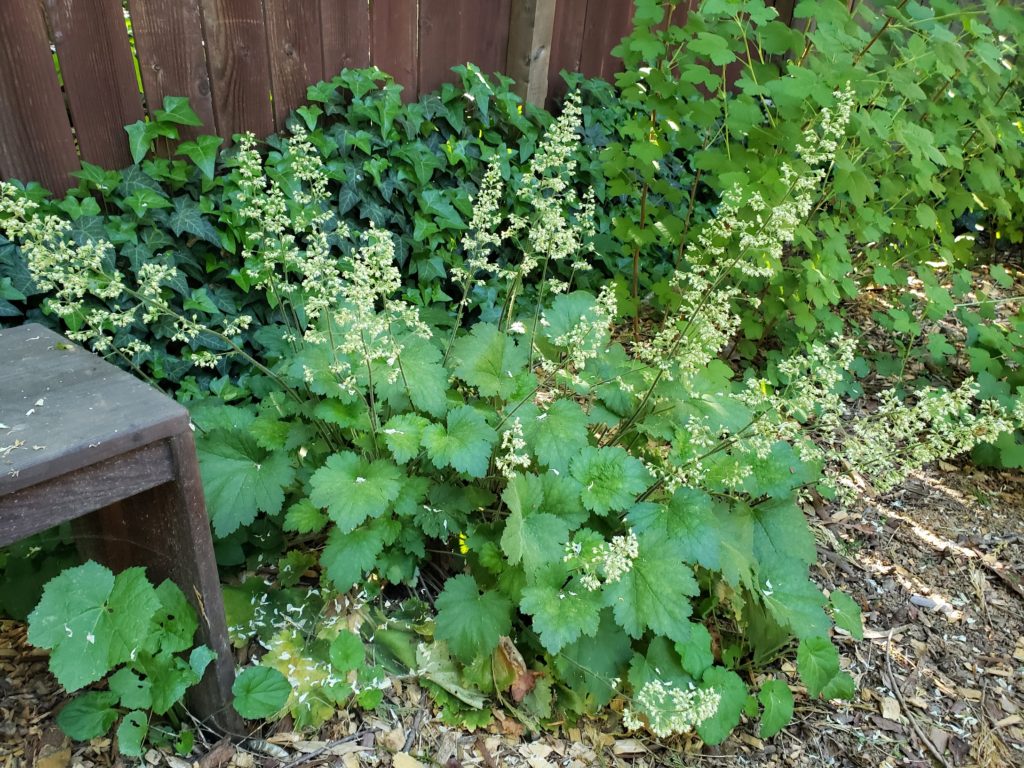Dappled shade is what most of us have here in Nevada County. And dry shade at that. Since we’re in one of the driest years in decades, and we’re in what’s being labelled a “megadrought”, we need to plant the plants that need the least water.
With ever warmer summers, shade from the forest around us is a blessing, cooling the air, providing relief from the heat of the days. But it’s a challenge to find attractive plants that grow with so little sun.
A pretty, low-water, shade-loving plant
Here’s one pretty plant that needs very little water and grows well in dappled to full, but bright, shade, and provides bright greenery under our trees: Island Alum Root, or Heuchera maxima. Yes, that’s the genus for coral bells. But this is not the familiar coral bells so commonly used in landscapes.
Heuchera maxima is an evergreen plant with bright green foliage. The plant has a mounding habit, getting 1-2 ft. tall and spreads with surface rhizomes to form a large clump up to 3 ft. wide. It blooms in the spring with white to pinkish flowers that reach up to 3 ft. The flowers are very attractive to hummingbirds.
It is a California native, but not to our area. It comes from three of the Channel Islands off the coast of Southern California, but has been found to be adaptable to garden situations so it has become quite popular throughout California and beyond. While it can live with regular watering, it takes considerable drought and deeper shade than other Heucheras (coral bells).
Island Alum Root does well in rocky soils, compared to other coral bells. It naturally grows on rocky cliffs and canyon walls on the islands it comes from. In coastal areas it can grow in full sun but in hotter inland areas it does well in partial shade or even up to full shade so long as it’s a bright shade. It’s also the largest of all the Heucheras.
Compare this plant with the more commonly planted coral bells which need a good humus-y soil and regular watering.

A good choice for under oaks
This Heuchera is especially good for planting under established oaks, since irrigating plants under oaks fosters the growth of Armillaria, or oak root fungus, which slowly kills the oaks. We don’t want that! Let’s preserve our oaks, those stately, drought tolerant, wildlife habitat-rich, shade trees and plant that dry shade underneath them with plants that need little to no supplemental water….plants like Heuchera maxima.
Is it deer resistant?
What’s more, H. maxima is deer resistant. However, for many plants, deer resistance is partly dependent on deer pressure. That is, what the deer population density in your area is and what the environmental factors are. This is an extremely low water year which means there’s less food for the deer which means they’ll be hungrier than usual. So plants that normally don’t get bothered by deer will be more vulnerable.
And deer will eat H. maxima only if things are really hard for them. If your Heuchera maxima or other plants start getting eaten, Liquid Fence, a deer repellant for plants, is your friend. Use it exactly as directed and you’ll save your plants.
So if you have mature oaks, dappled shade, or simply realize the need for low-water landscape choices for your shady areas, Island Alum Root and Western Sword Fern are two great choices for dry shade.
Here’s another native Heuchera
The coral bells native to our area is H. micrantha, common name “crevice alumroot”. And you’ll find it in…crevices. I’ve seen it in very dry crevices in rocks up in the Sierras and around Nevada County you may see it hanging onto rocky cliff sides at the edges of waterfalls and other moist areas. It’s a Heuchera that is native to much of coastal and mountainous California. It’s another tough plant that takes shade and low water.
You may get these plants from your local nursery if you ask them to get it, or look them up on the Calscape.org website to find nurseries that carry them or provide them to retail nurseries.
If you want to be able to pronounce Heuchera properly, don’t worry, there a few ways to do so. The ch is a hard ch. So you can say “hookera”, “hewkera”, or “hukera”. I say “hewkera”. For this plant the scientific name may be more often used than the common name.
Have dry shade? Plant this one and save water.

